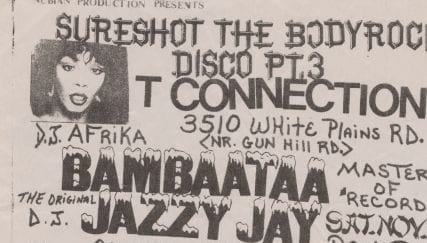by Clara Valenzuela, PhD Student, Musicology

While DIY musical ethics have typically been credited as being pioneered by the hardcore punk scene of the early 1980s, the early hip hop scene of the late 1970s engaged in a strikingly similar ethic and aesthetic. Hip hop DJs, MCs, b-boys, and graffiti artists threw free or cheap block parties or shows in informal venues to audiences of all ages. The early hip hop participants were far removed from the music industry, focusing their musical creation within their working class communities in the South Bronx. DJs and MCs circulated their LPs and cassettes free from corporate interference or profit incentives. Amateurism and experimentalism were the backbone of the hip hop scene; kids eager to join in on the movement could teach themselves how to breakdance, make graffiti art, or DJ.
Similarly, punks in the 1980s American hardcore scene practiced a musical ethic of “DIY” or “doing it yourself”; an anti-corporate, anarchistic way of making music. Rather than participating in the mainstream music industry, hardcore bands started their own independent labels, released their own music, and booked their own shows. Punks were encouraged to teach themselves the skills necessary to participate in every facet of musical production, such as making flyers, organizing shows, cutting and folding 7″s, and self-recording. The hardcore scene depended on volunteer labor to reproduce itself; amateurism was embraced, professionalism was disavowed, and any potential profit-motives had to be rejected. Rather than playing at clubs or professional 21+ venues, hardcore punks played all ages shows in warehouses, churches, each other’s homes, beaches, and community centers.
The DIY ethic gave way to a visual DIY aesthetic best exemplified through punk art on flyers, album covers, merch, and zines. Zines and flyers were typically either hand-drawn or hand-made collages xeroxed into oblivion. The 1982 flyer to the left serves as an example of this visual DIY aesthetic associated with the punk scene of the time. The letters and illustrations are crudely drawn in sharpie, there is no information regarding admission price or 21+ restriction, and the show’s location is simply “the pier.”

The hip hop flyer to the right, for a 1979 show featuring DJ Kool Herc, Jazzy Jay, and Afrika Bambaataa. mirrors the DIY aesthetics commonly associated with punk flyers; the flyer is hand-drawn and makes use of collage letters or images copied through a xerox machine. The show is located at an unlabeled address – presumably, not a professional music venue – and has no age limit or required admission cost.
These two flyers exemplify the similarities in both the ethics and aesthetics within both the punk and hip hop scenes. Though they did not use the language of “do it yourself” explicitly, the early hip hop scene participated in a DIY practice that oftentimes goes unnoticed or ignored by music historians. The absence of hip hop in discourses and histories of DIY perhaps points to the ways in which practicing an ethic of DIY may be distinguished from practicing DIY out of economic necessity. Seeing as the hardcore punk scene was largely made up of white, middle-class men, how do DIY ethics imply an ascetic disavowal of class privilege and economic mobility? And how does this coding of DIY ethics implicate race, effectively leaving out Black working class musical communities like hip hop?
Primary Sources.
American Hardcore: The History of American Punk Rock 1980-1986. Directed by Paul Rachman. 2006: Sony Pictures.
Secondary Sources
Chang, Jeff. Can’t Stop, Won’t Stop: a History of the Hip-Hop Generation. New York: Picador, 2006.
Azerrad, Michael. Our Band Could Be Your Life: Scenes from the American Indie Underground, 1981-1991. Boston: Little, Brown, 2001.
